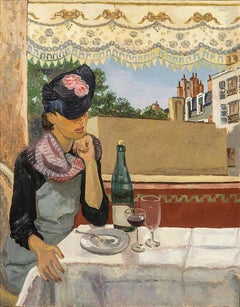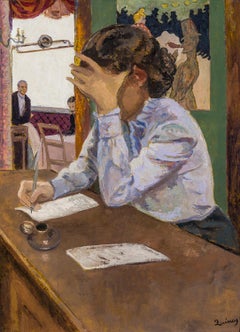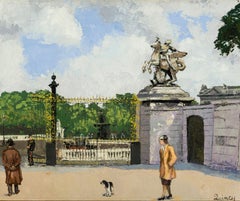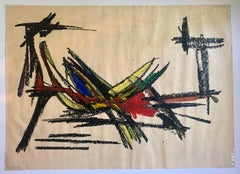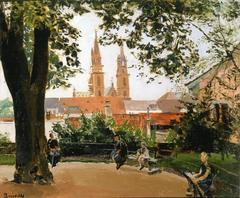Edmund Quincy Art
to
1
4
Overall Width
to
Overall Height
to
5
2
2
4
1
3
3
1
1
1
1
1
1
1
3
3
3
3
2
5
8,816
2,808
1,655
1,313
3
3
2
Artist: Edmund Quincy
Table by the Window
By Edmund Quincy
Located in New York, NY
Estate stamp (on back, on original stretcher): Estate of/ Edmund Quincy/ 1903-1997 ///
Category
20th Century American Realist Edmund Quincy Art
Materials
Canvas, Oil
The Writer
By Edmund Quincy
Located in New York, NY
Signed (lower right): Quincy
Category
20th Century American Realist Edmund Quincy Art
Materials
Canvas, Oil
Abstract Composition EQ1, 1962 - crayon, 66x48 cm, framed
By Edmund Quincy
Located in Nice, FR
Fusain on paper, signed lower right
Category
1960s Abstract Edmund Quincy Art
Materials
Crayon
Jardin des Tuileries, Paris
By Edmund Quincy
Located in New York, NY
Signed (lower right): Quincy
Category
20th Century American Realist Edmund Quincy Art
Materials
Canvas, Oil
Abstract Composition EQ2, 1962 - crayon, 66x48 cm, framed
By Edmund Quincy
Located in Nice, FR
Fusain on paper, signed lower right.
Category
1960s Abstract Edmund Quincy Art
Materials
Crayon
Related Items
1960s "Fruit Bowl in Mexico" Gouache & Oil Pastel Abstract Mid Century
By Gloria Dudfield
Located in Arp, TX
Gloria Dudfield
Mexican Fruit Bowl
1960s
Oil Pastel and Gouache on Paper
36"x32" unframed $1600
*Custom framing available for additional charge. Please...
Category
Mid-20th Century Abstract Edmund Quincy Art
Materials
Paper, Oil Pastel, Gouache
$720 Sale Price
55% Off
H 26 in W 36 in D 0.5 in
Street of the Old Quarter British School signed Cade oil on canvas painting
Located in Barcelona, Barcelona
**Technical Sheet**
**Title:** "Street of the Old Quarter"
**Author:** British School, 19th Century
**Date:** 1892
**Technique:** Oil on canvas
**Dimensions:** 14.17 x 10.63 inc...
Category
1890s American Realist Edmund Quincy Art
Materials
Canvas, Oil
$889 Sale Price
37% Off
H 14.18 in W 10.63 in
1960s "Storm at Sea" Gouache and Oil Pastel Abstract SF Artist
By Gloria Dudfield
Located in Arp, TX
Storm at Sea
1960s
Gouache and Oil Pastel on paper
35.75"x33.25 float mount black wood frame measures 38.5"x1.5"x36"
Gloria (Fischer) Dudfield
July 12, 1922 – May 27, 2015
Came from...
Category
Mid-20th Century Abstract Edmund Quincy Art
Materials
Paper, Oil Pastel, Gouache
$2,400 Sale Price
46% Off
H 38.5 in W 36 in D 1.5 in
Portrait of 19th Century Philadelphia Merchant, Quintin Campbell
Located in Doylestown, PA
19th Century portrait of Quintin Campbell in the style of Thomas Sully. The 30 x 25 inches oil on canvas is framed in an ornate frame. Provenance: Private collection, Bucks County, P...
Category
19th Century American Realist Edmund Quincy Art
Materials
Canvas, Oil
Portrait of a Lady, Oil on Canvas, 1840's, In Style of Jacob Eichholtz
Located in Doylestown, PA
This interior portrait of a woman dressed in an elegant lace shawl is a 30" x 25" oil on canvas painting in the style of Jacob Eichholtz. The artist is unknown but the painting is believed to have been painted in the 1840's. It is not signed but framed and in good condition. Provenance: Private Collection, Old Queens Gallery...
Category
Mid-19th Century American Realist Edmund Quincy Art
Materials
Canvas, Oil
$750
H 34 in W 28 in D 2 in
Under the Viaduct American Scene Social Realism WPA Era Mid-20th Century Modern
Located in New York, NY
Under the Viaduct American Scene Social Realism WPA Era Mid-20th Century Modern
Syd J. Browne (1907-1991)
Under the Viaduct
22 x 30 inches
Oil on canvas. c. 1930s
Signed lower left
...
Category
1930s American Realist Edmund Quincy Art
Materials
Canvas, Oil
Columbus Avenue NYC c. 1920s/30s American Scene Ashcan WPA Modern 20th Century
By Bernard Gussow
Located in New York, NY
Columbus Avenue NYC c. 1920s/30s American Scene Ashcan WPA Modern 20th Century
"Late Afternoon, Columbus Avenue, New York", impasto oil on canvas, signed lower left, signed verso (under relining, shown in photo), and titled verso on stretcher, in maple mitered cove frame, 23 1/4" x 27 1/4", SS: 19 1/4" x 23 1/4", Relined.
BIO
Russian-born Gussow trained at the Art Students League and the National Academy of Design. He also studied under Bonnat at the Ecole des Beaux-Arts in Paris. His first claim to fame was exhibiting two works at the Armory Show in 1913. Gussow exhibited at the Society of Independent Artists between 1917 and 1934 and at Salons of America in the 1930s.
The Whitney Museum of American Art, for example, has his Subway Stairs. The Barnes Foundation...
Category
1920s American Realist Edmund Quincy Art
Materials
Canvas, Oil
Antique American Oil Painting Portrait Young Woman Necklace Period Frame Rare
Located in Buffalo, NY
A beautiful and rare antique American portrait of a young woman in a stunning period frame, likely original to the piece.
Unsigned but beaut...
Category
1890s American Realist Edmund Quincy Art
Materials
Canvas, Oil
$1,289
H 12 in W 10 in
Industrial Railroad WPA Mid 20th Century American Scene Rural Modern Realism
By Louis Bosa
Located in New York, NY
Industrial Railroad WPA Mid 20th Century American Scene Rural Modern Realism
Large oil on canvas genre painting depicting laborers working on a railroad, with rural landscape in the...
Category
1940s American Realist Edmund Quincy Art
Materials
Canvas, Oil
$11,500
H 29 in W 35 in D 3 in
'Sketching Wisconsin' original oil painting, Signed
By John Steuart Curry
Located in Milwaukee, WI
John Steuart Curry
"Sketching Wisconsin," 1946
oil on canvas
31.13 x 28 inches, canvas
39.75 x 36.75 x 2.5 inches, frame
Signed and dated lower right
Overall excellent condition
Presented in a 24-karat gold leaf hand-carved wood frame
John Steuart Curry (1897-1946) was an American regionalist painter active during the Great Depression and into World War II. He was born in Kansas on his family’s farm but went on to study art in Chicago, Paris and New York as young man. In Paris, he was exposed to the work of masters such as Peter Paul Rubens, Eugène Delacroix and Jacques-Louis David. As he matured, his work showed the influence of these masters, especially in his compositional decisions. Like the two other Midwestern regionalist artists that are most often grouped with him, Grant Wood (American, 1891-1942) and Thomas Hart Benton (American, 1889-1975), Curry was interested in representational works containing distinctly American subject matter. This was contrary to the popular art at the time, which was moving closer and closer to abstraction and individual expression.
Sketching Wisconsin is an oil painting completed in 1946, the last year of John Steuart Curry’s life, during which time he was the artist-in-residence at the University of Wisconsin in Madison. The painting is significant in Curry’s body of work both as a very revealing self-portrait, and as a landscape that clearly and sensitively depicts the scenery of southern Wisconsin near Madison. It is also a portrait of the artist’s second wife, Kathleen Gould Curry, and is unique in that it contains a ‘picture within a picture,’ a compositional element that many early painting masters used to draw the eye of the viewer. This particular artwork adds a new twist to this theme: Curry’s wife is creating essentially the same painting the viewer is looking at when viewing Sketching Wisconsin.
The triangular composition of the figures in the foreground immediately brings focus to a younger Curry, whose head penetrates the horizon line and whose gaze looks out towards the viewer. The eye then moves down to Mrs. Curry, who, seated on a folding stool and with her hand raised to paint the canvas on the easel before her, anchors the triangular composition. The shape is repeated in the legs of the stool and the easel. Behind the two figures, stripes of furrowed fields fall away gently down the hillside to a farmstead and small lake below. Beyond the lake, patches of field and forest rise and fall into the distance, and eventually give way to blue hills.
Here, Curry has subverted the traditional artist’s self-portrait by portraying himself as a farmer first and an artist second. He rejects what he sees as an elitist art world of the East Coast and Europe. In this self-portrait he depicts himself without any pretense or the instruments of his profession and with a red tractor standing in the field behind him as if he was taking a break from the field work. Here, Curry’s wife symbolizes John Steuart Curry’s identity as an artist. Compared with a self-portrait of the artist completed a decade earlier, this work shows a marked departure from how the artist previously presented and viewed himself. In the earlier portrait, Curry depicted himself in the studio with brushes in hand, and with some of his more recognizable and successful canvases behind him. But in Sketching Wisconsin, Curry has taken himself out of the studio and into the field, indicating a shift in the artist’s self-conception.
Sketching Wisconsin’s rural subject also expresses Curry’s populist ideals, that art could be relevant to anyone. This followed the broad educational objectives of UW’s artist-in-residence program. Curry was appointed to his position at the University of Wisconsin in 1937 and was the first person to hold any such position in the country, the purpose of which was to serve as an educational resource to the people of the state. He embraced his role at the University with zeal and not only opened the doors of his campus studio in the School of Agriculture to the community, but also spent a great deal of time traveling around the state of Wisconsin to visit rural artists who could benefit from his expertise. It was during his ten years in the program that Curry was able to put into practice his belief that art should be meaningful to the rural populace. However, during this time he also struggled with public criticism, as the dominant forces of the art market were moving away from representation. Perhaps it was Curry’s desire for public acceptance during the latter part of his career that caused him to portray himself as an Everyman in Sketching Wisconsin.
Beyond its importance as a portrait of the artist, Sketching Wisconsin is also a detailed and sensitive landscape that shows us Curry’s deep personal connection to his environment. The landscape here can be compared to Wisconsin Landscape of 1938-39 (the Metropolitan Museum of Art), which presents a similar tableau of rolling hills with a patchwork of fields. Like Wisconsin Landscape, this is an incredibly detailed and expressive depiction of a place close to the artist’s heart. This expressive landscape is certainly the result of many hours spent sketching people, animals, weather conditions and topography of Wisconsin as Curry traveled around the state. The backdrop of undulating hills and the sweeping horizon, and the emotions evoked by it, are emphatically recognizable as the ‘driftless’ area of south-central Wisconsin. But while the Metropolitan’s Wisconsin Landscape conveys a sense of uncertainty or foreboding with its dramatic spring cloudscape and alternating bands of light and dark, Sketching Wisconsin has a warm and reflective mood. The colors of the foliage indicate that it is late summer and Curry seems to look out at the viewer approvingly, as if satisfied with the fertile ground surrounding him.
The landscape in Sketching Wisconsin is also revealing of what became one of Curry’s passions while artist-in-residence at UW’s School of Agriculture – soil conservation. When Curry was a child in Kansas, he saw his father almost lose his farm and its soil to the erosion of The Dust Bowl. Therefore, he was very enthusiastic about ideas from UW’s School of Agriculture on soil conservation methods being used on Wisconsin farms. In Sketching Wisconsin, we see evidence of crop rotation methods in the terraced stripes of fields leading down the hillside away from the Curry’s and in how they alternate between cultivated and fallow fields.
Overall, Sketching Wisconsin has a warm, reflective, and comfortably pastoral atmosphere, and the perceived shift in Curry’s self-image that is evident in the portrait is a positive one. After his rise to favor in the art world in the 1930’s, and then rejection from it due to the strong beliefs presented in his art, Curry is satisfied and proud to be farmer in this self-portrait. Curry suffered from high blood...
Category
1940s American Realist Edmund Quincy Art
Materials
Canvas, Oil
$652,500
H 39.75 in W 36.75 in D 2.5 in
NYC EL American Scene Social Realism Mid 20th Century Modern WPA Era Figurative
By Cecil Crosley Bell
Located in New York, NY
NYC EL American Scene Social Realism Mid 20th Century Modern WPA Era Figurative
Cecil Bell (1906 – 1970)
Street Life Under the EL
22 x 30 inches
Oil on canvas, c. 1930s
Signed upper...
Category
1930s American Realist Edmund Quincy Art
Materials
Canvas, Oil
UNION SQUARE Depression Era Oil Painting WPA Realism American Scene Realism NYC
By Jo Cain
Located in New York, NY
UNION SQUARE Depression Era Oil Painting WPA Realism American Scene Realism NYC
Jo Cain (1904 – 2003)
"Union Square"
24 x 36 inches
Oil on canvas, c.1940s
S...
Category
1940s American Realist Edmund Quincy Art
Materials
Canvas, Oil
$33,000
H 31 in W 43 in D 2 in
Previously Available Items
Park Near a Cathedral
By Edmund Quincy
Located in New York, NY
Signed (at lower left): Quincy
City image / City life
A true son of Boston, Edmund Quincy devoted his artistic career to recording the spirit of the older neighborhoods of the ci...
Category
20th Century American Realist Edmund Quincy Art
Materials
Canvas, Oil
Edmund Quincy art for sale on 1stDibs.
Find a wide variety of authentic Edmund Quincy art available for sale on 1stDibs. You can also browse by medium to find art by Edmund Quincy in canvas, fabric, oil paint and more. Much of the original work by this artist or collective was created during the 20th century and is mostly associated with the abstract style. Not every interior allows for large Edmund Quincy art, so small editions measuring 16 inches across are available. Customers who are interested in this artist might also find the work of Irene Rice Pereira, Hildegarde Haas, and Daniel Ralph Celentano. Edmund Quincy art prices can differ depending upon medium, time period and other attributes. On 1stDibs, the price for these items starts at $1,621 and tops out at $36,000, while the average work can sell for $17,500.
Artists Similar to Edmund Quincy
Mike Dargas
